Opt-in text messaging: SMS consent language and requirements for call to action disclaimers [templates]
You need subscriber consent to text contacts from your business. Keep it simple with these compliant opt-in tools, templates, and examples.
Compliant business texting requires opt-in consent. This means you must ask contacts to opt in before you text them.
SMS opt-in requirements apply to the calls to action you use to influence contacts to consent to receiving your texts. These requirements also apply to how you organize this data.
Read on for a brief overview of SMS opt-in requirements.
⚠️ This advice is for informational purposes only and is neither intended as nor should be substituted for consultation with appropriate legal counsel and/or your organization’s regulatory compliance team.
What are the SMS opt-in requirements?
SMS opt-in requirements checklist:
- Prior express consent: Allow contacts “to avoid receiving calls made using an artificial or prerecorded voice to which they have not given their prior express consent” according to the TCPA. While this reads as “voice”, the FCC applies these rules to text messaging, too. The CTIA reiterates this SMS opt-in requirement, “messages should be sent only after the Consumer has opted-in to receive them.” Learn more about express written consent (and other types of consent) here.
- Clear disclaimer: The TCPA states, “the notice is clear and conspicuous and on the first page of the unsolicited advertisement”. This applies to your calls to action.
- Data retention: The CTIA notes, “Message Senders should also document opt-in consent by retaining the following data where applicable”. Depending on how people opt in, you must collect time (i.e. when opted in), medium (e.g. SMS keyword), capture (i.e. what you and they sent) campaign, phone number, identity (e.g. name), and IP address.
- Opt-in confirmation: The CTIA states you must confirm opt-in: “the Message Sender should send the Consumer an opt-in confirmation message before any additional messaging is sent.” Learn more about the opt-in confirmation message requirements here.
- Single use only: The CTIA requires that you collect contact information for your organization’s use only, which they refer to as a single campaign: “A Consumer opt-in to receive messages should not be transferable or assignable. A Consumer opt-in should apply only to the campaign(s) and specific Message Sender for which it was intended or obtained.”
SMS consent language checklist (for your call to action):
- Program name: The CTIA requires your call to action disclosure to have “the program or product description”. This could be your keyword they texted you to opt in or your brand name.
- Phone number: You must include the number from which you’ll send text messages. The TCPA says, “the notice includes a domestic contact telephone and facsimile machine number”, which is specifically helpful for contacts to opt out.
- Purpose: Especially important for promotional text messages that require express written consent, it is a best practice to include language in your disclaimer as to what the contact is opting in to receive (e.g. “You consent to receive promotional messages”).
- Permission: Language like “You agree” or “You consent to receive” is the permission they provide you to send them those types of messages.
- Opt out instructions: The TCPA requires that “the notice states that the recipient may make a request to the sender of the unsolicited advertisement not to send any future unsolicited advertisements”.
- Help instructions: The CTIA requires that “customer care contact information” (support instructions) must be present.
- Message and data rates may apply: The TCPA requires senders to allow contacts to opt out with “a cost-free mechanism for a recipient to transmit a request pursuant to such notice to the sender of the unsolicited advertisement”.
- Condition of purchase: As with message and data rates, opting in to receive promotional text messages shouldn’t require monetary exchange. The CTIA requires “clear and conspicuous languages about opt-in and any associated fees or charges”.
- Terms of service: Include a link to your terms and conditions if they are not fully listed in the disclosure notice. Learn more about SMS terms of service requirements here.
- Privacy policy: Like terms of service, include a link to your privacy policy if it isn’t written in full in the disclaimer. Learn more about SMS privacy policy requirements here.
- Frequency: While the CTIA requires this mainly in the confirmation message, it’s best practice to include language such as “message frequency varies” in your call to action notice, too.
Copy/paste business texting call to action opt-in disclaimer templates to collect phone numbers compliantly
It’s essential to get your contacts’ permission to text them before you text them. (You could face fines for infractions — among other penalties.)
While that might sound intimidating, you can include simple disclaimers with your calls to action (to join your text subscriber list) that will help you collect contact information compliantly.
Start with SimpleTexting’s opt-in list-building tools
You can use SimpleTexting’s handy tools to automatically create compliant opt-in list building assets like graphics and web forms:
- Text-to-subscribe keyword graphic generator
- Click-to-text buttons
- Web text-to-signup forms
- Mobile text message signup widgets
When you use these tools, compliance language is automatically added to your assets. This way, you don’t need to copy/paste any templates and can build your list with confidence.
If you’d like to advertise signing up for your texting program using any tools other than those SimpleTexting provides, use the copy/paste templates below as starting points for opt-in text message compliance.
Text-to-subscribe opt-in language template
Copy/paste/edit template (edit the bolded items):
Brand Name: By texting KEYWORD to (123) 456-7890, you agree to receive promotional messages sent via an autodialer. You also agree to the terms of service (website.com/terms-and-conditions/) and privacy policy (website.com/privacy-policy/). This agreement isn’t a condition of any purchase. Message frequency varies. Message and data rates may apply. Reply STOP to opt out; HELP for more information.
Here’s an example I created with Canva with an edited disclaimer:

Include an opt-in disclaimer like this in printed and digital graphics where you collect contacts you intend to text, like:
- Text to vote
- Text to win
- Text to apply
- Text to donate
- Text to join
- Link to text
- QR code to text
- Text question to
Note: Your graphics automatically include opt-in disclaimers when you use SimpleTexting’s text-to-subscribe keyword graphic generator.
📕 Resource: Here are 20 free Canva templates to advertise your text marketing list — all complete with SMS call to action opt-in requirements.
Form opt-in language template
Copy/paste/edit template (edit the bolded items):
Brand Name: By checking this box, you agree to receive promotional messages sent via an autodialer from (123) 456-7890. You also agree to the terms of service (website.com/terms-and-conditions/) and privacy policy (website.com/privacy-policy/). This agreement isn’t a condition of any purchase. Message frequency varies. Message and data rates may apply. Reply STOP to opt out; HELP for more information.
Here’s an example I created with SimpleTexting’s web form builder that automatically creates the opt-in disclaimer:
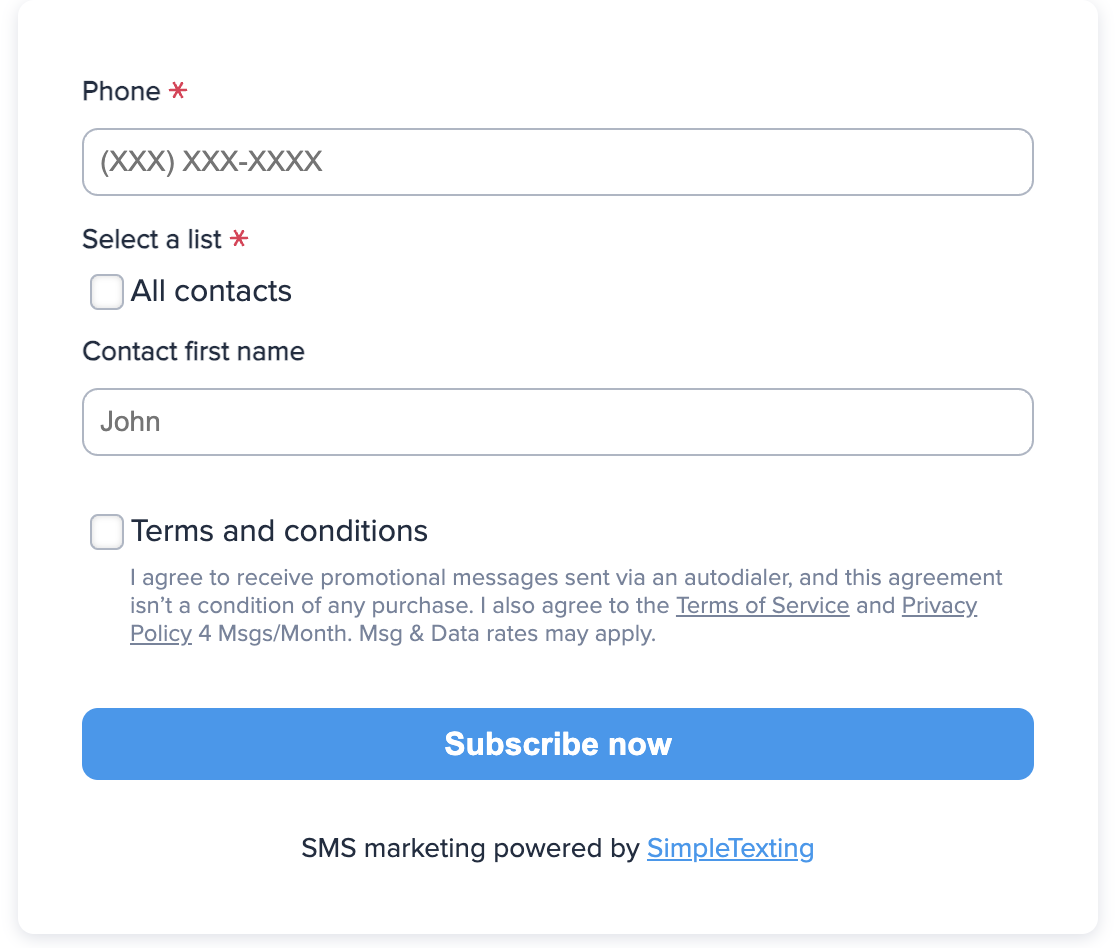
Include an opt-in disclaimer like this in web forms where you collect contacts you intend to text. Forms must include an unselected checkbox where contacts consent to the agreement.
Note: Your forms automatically include opt-in disclaimers when you use SimpleTexting’s web signup form builder.
Best practices to write a compliant SMS opt-in disclaimer for your call to action
There are different types of consent you could gather depending on the types of text messages your business will send.
That said, if you include the language from the templates in this guide, you’ll have express written consent, which allows you to send promotional, informational, and conversational text messages. That’s why I recommend always getting express written consent for business texting use cases as a best practice.
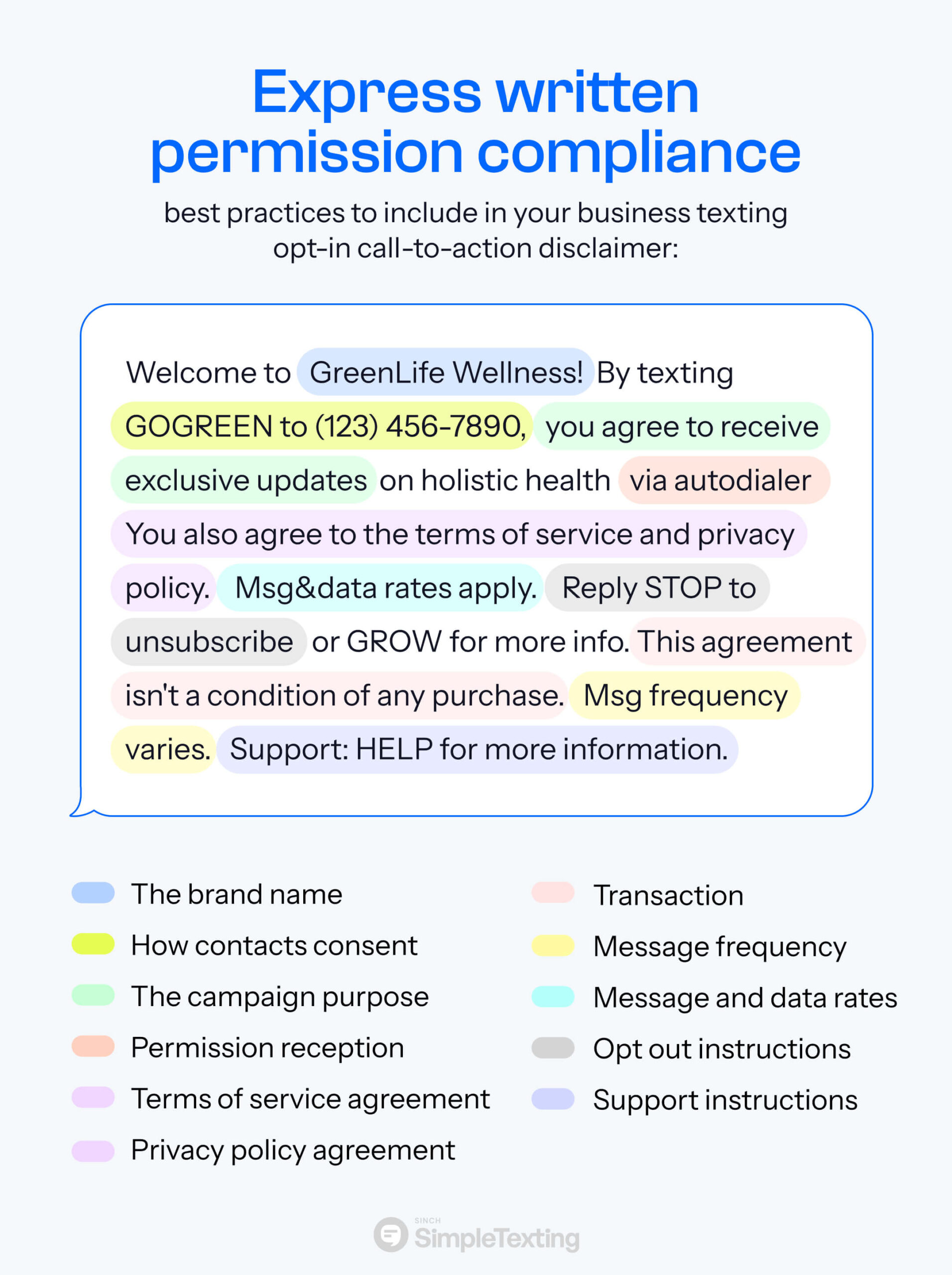
Express written permission compliance best practices to include in your business texting opt-in call-to-action disclaimer:
- The brand name (e.g. “Name: …”)
- How contacts consent (e.g. “…By texting KEYWORD to (123) 456-7890, you agree…”)
- The campaign purpose (e.g. “…you agree to receive promotional messages…”)
- Permission reception (e.g. “…via an autodialer…”)
- Terms of service agreement (e.g. “…You also agree to the terms of service…”)
- Privacy policy agreement (e.g. “…and privacy policy…”)
- Transaction: (e.g. “…This agreement isn’t a condition of any purchase…”)
- Message frequency (e.g. “…Message frequency varies…”)
- Message and data rates (e.g. “…Message and data rates may apply…”)
- Opt out instructions (e.g. “…Reply STOP to opt out…”)
- Support instructions (e.g. “…HELP for more information.”)
Again, here’s that disclaimer copy/paste template:
Brand Name: By texting KEYWORD to (123) 456-7890, you agree to receive promotional messages sent via an autodialer. You also agree to the terms of service (website.com/terms-and-conditions/) and privacy policy (website.com/privacy-policy/). This agreement isn’t a condition of any purchase. Message frequency varies. Message and data rates may apply. Reply STOP to opt out; HELP for more information.
Approved abbreviations
Business texting is rich with jargon and abbreviations. And when you’re up against a tight character limit, the temptation to shorten your words is real.
In an effort to help you avoid confusion or misdirection with any of your compliance messaging, the CTIA developed a list of approved abbreviations you can use in your texting program that will help you save space without sacrificing clarity.
Approved CTIA abbreviations include:
- “Msg” instead of “message”
- “/” instead of “per”
- “Txt” instead of “T”text”
- “Mo, ea. mo. or /mth instead of “per month”
- “Msg&data rates may apply” instead of “message and data rates may apply”
Other requirements
There are a few other CTIA required provisos on promotion:
- Avoid the word free. Different data plans for different people may result in overage fees for certain people. It’s best to just steer clear of the word entirely.
- If you’re offering an incentive for opting-in (like a discount) keep it simple, and follow through. Don’t promise something that you can’t deliver on. And don’t give customers any extra hoops to jump through that weren’t clearly stated in the promotion.
- Do not share, endorse, demonstrate, or depict violence or illegal behavior of any kind including illegal or illicit drugs. You cannot share “adult content” as defined by the CTIA here. And of course, no profanity or hate speech.
A mnemonic aid to remember opt-in call-to-action compliance: The CXI Framework
If you’re like me, you might like a framework to remember these 11 points of opt-in language. Personally, I use a variation of the Method of Loci with a little framework I call CXI.
Method of Loci: Associating items with specific locations in a familiar place, like a room or a street.
CXI: What I use to remember “Compliance Eleven”. I think about it like inviting someone to my house for a party:
- Brand: House (where)
- Consent: Entering the front door (how)
- Purpose: Reason for visiting (what)
- Permission: Invitation card (why)
- Terms: House rules
- Privacy: Promise
- Transaction: No need to bring anything
- Frequency: Time and date (when)
- Data: You’re responsible for your transportation
- Stop: RSVP (let me know if you can’t make it)
- Help: Let me know if you have any questions
For me, it makes sense to think of this language as key information someone needs to know to understand what to expect. Like an invitation, consent is like accepting an RSVP.
So if that memory aid is useful for you, feel free to save this amazing visual from our talented designers, Tim Walker and Shirel Krafman 😍
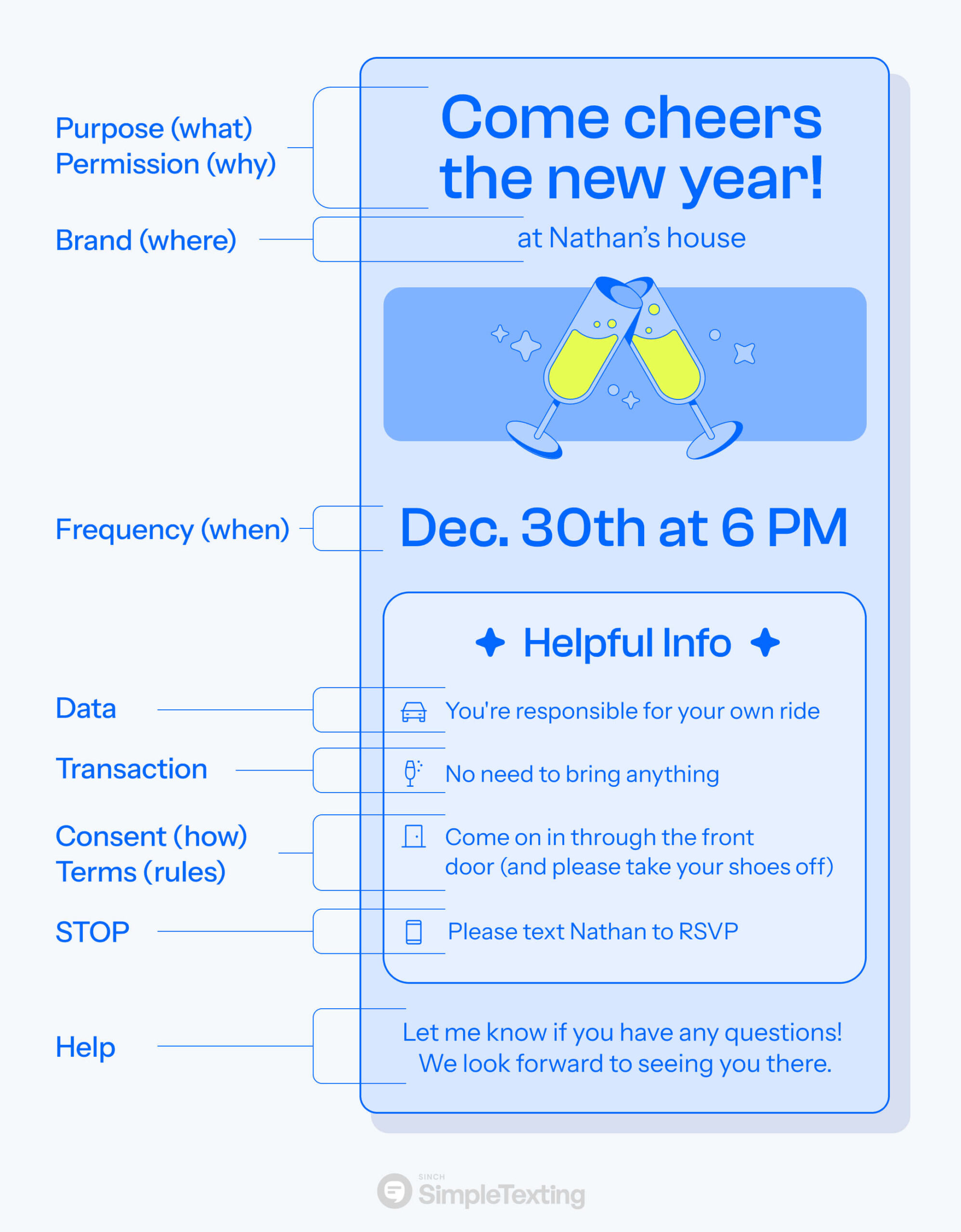
Compliant SMS opt-in methods
The CTIA’s Messaging Principles and Best Practices handbook provides several examples of compliant SMS methods:
Depending upon the circumstances, a Consumer might demonstrate opt-in consent to receive messaging traffic through several mechanisms, including but not limited to:
- Entering a telephone number through a website;
- Clicking a button on a mobile webpage;
- Sending a message from the Consumer’s mobile device that contains an advertising keyword;
- Initiating the text message exchange in which the Message Sender replies to the Consumer only with responsive information;
- Signing up at a point-of-sale (POS) or other Message Sender on-site location; or
- Opting-in over the phone using interactive voice response (IVR) technology.
If you’ve read our resource about express written consent, you’ll note some of these opt-in methods use implied consent (i.e. responding to a contact who first texts you) and express consent (i.e. point-of-sale phone number collection with the goal of sending transactional messages).
We highly recommend gaining express written consent, which allows you to send promotional messages as well as informational and conversational messages.
Therefore, a shortlist of the best ways to write SMS opt-in calls to action to express written consent include:
- Text-to-subscribe keywords
- Forms with unchecked boxes
- Click to text message
Text-to-subscribe keyword
Keywords are memorable words or phrases that people text your business number to opt in.
You may have seen this before when a brand says to text a word to their number (ex. “Text SUMMERDEALS to 888-459-2034”).
📕 Resource: Learn more about setting up a text-to-join keyword to collect contacts.
Forms with unchecked boxes
Web signup forms allow website visitors to easily subscribe to receive texts from you. You’ll need to set up a form and install it on your site.
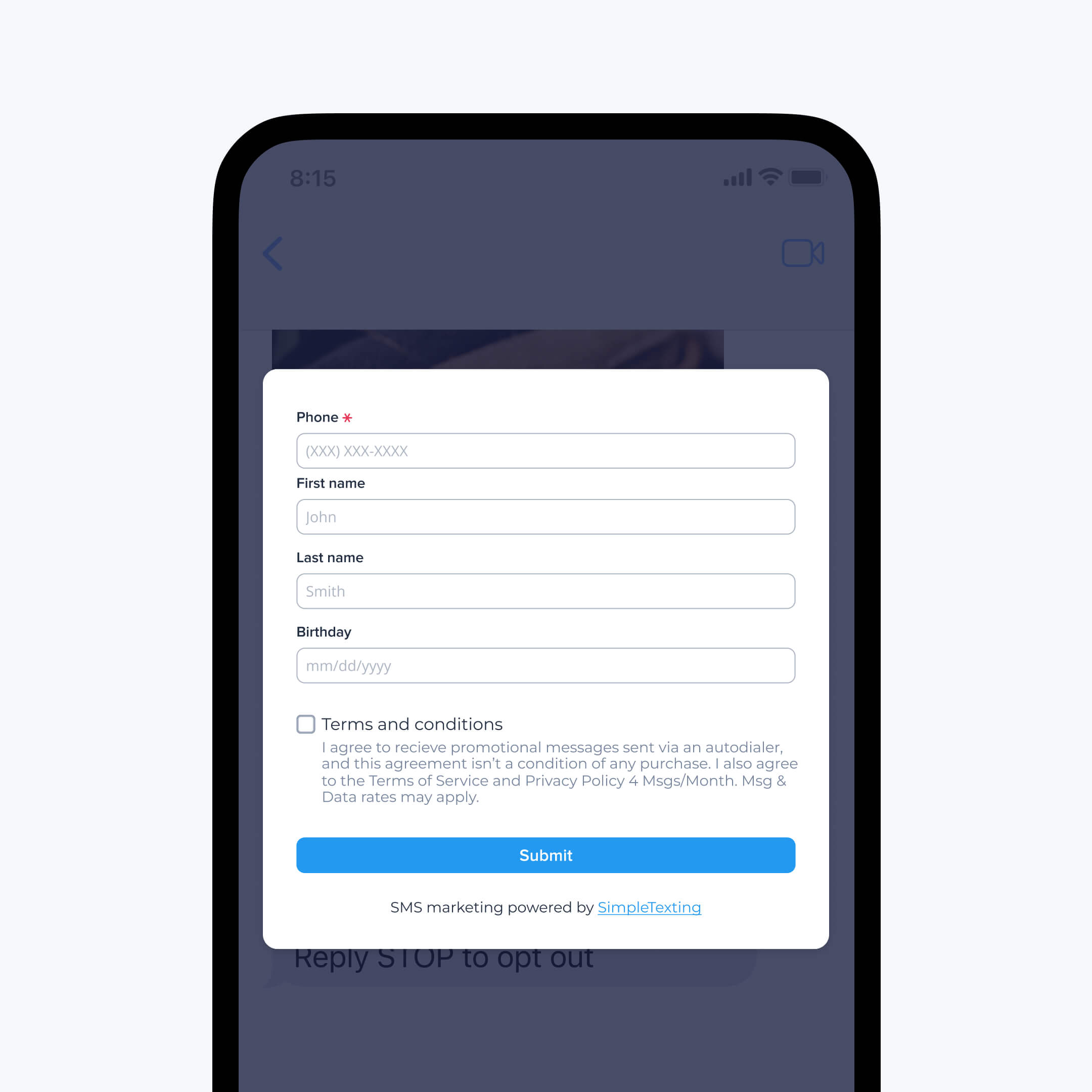
Luckily, we have a free website form builder app in the SimpleTexting platform that you can use. It’s super easy to customize and install the form, and there’s no need for an integration or even a developer to build it.
💡 Tip: If you decide to add a phone number field to an existing form, a) make sure the text message opt-in language is TCPA compliant, and b) be sure to have a box that users must check to opt-in for messages. This checkbox cannot be pre-checked.
What if you already ask for people’s phone numbers on a paper or electronic form?
These forms — like registration or order forms — are a convenient place to invite people to opt in to your text messages, since they’re already providing their number.
Your opt-in form needs to have an unchecked checkbox and a disclaimer that the person filling out the form agrees to receive your text messages. Make sure the checkbox isn’t pre-checked.
Click to text message
You can create:
- A button that sends a text message
- A link that sends a text message
- A QR code that sends a text message
All of these SMS opt-in methods are a form of click to text message.
Essentially, you create a link that when clicked opens a phone’s native text message app and automatically populates a text message to send to your phone number. When the contact sends that text message to your number, they opt in to receive your texts by providing express written consent.
For example, Backcountry uses a button to text message to encourage compliant opt-ins from website visitors:
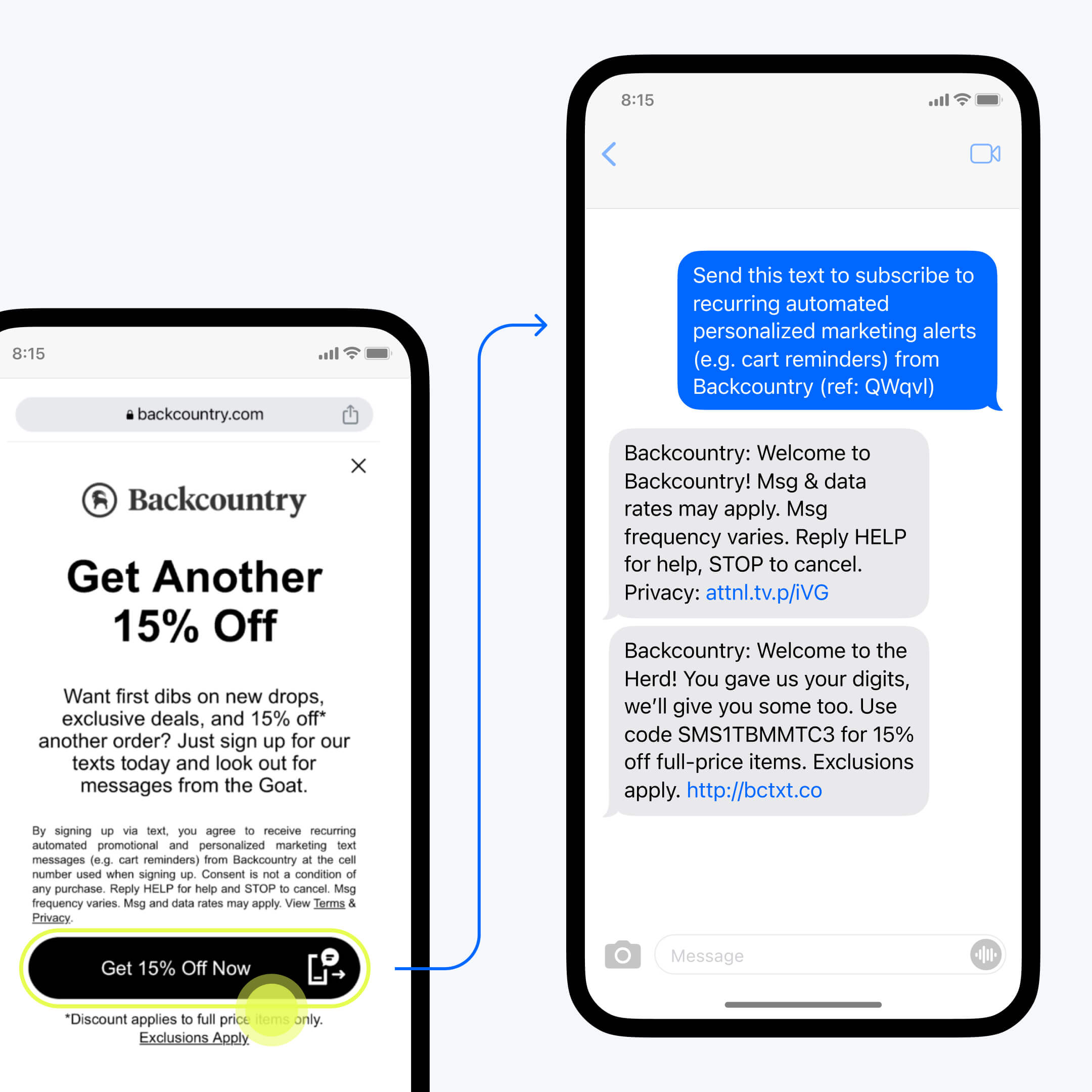
When you click the button, the text message automatically populates in your phone’s native messaging app. You simply send the text to the automatically applied phone number to opt in.
SMS opt-in FAQs
Do employees have to opt-in for text messages?
That said, it’s always best practice to tell them what you’re going to text them and provide a clear way to opt out.
Can you send a text to opt in?
If a customer texts you first, and you’re not sending them promotional messages, it may fall under conversational consent under TCPA guidelines since they’d reasonably expect a reply. If you’re unsure, get your recipients’ permission using a compliant opt-in method.
What is the opt-in process for text messages?
Key takeaways
- Contacts must opt in to receive messages from your organization before you text them.
- Your call to action to subscribe to your text list must be clear and conspicuous. The notice should include the program name, consent agreement, purpose, permission, terms of service link, privacy policy link, transaction conditions, message frequency, data rates, opt out instructions, and customer care instructions.
- You must document and retain consent information from your contacts.
- You must send an opt-in confirmation message.
- Opt-ins are not transferable to other organizations.
⚠️ This advice is for informational purposes only and is neither intended as nor should be substituted for consultation with appropriate legal counsel and/or your organization’s regulatory compliance team.